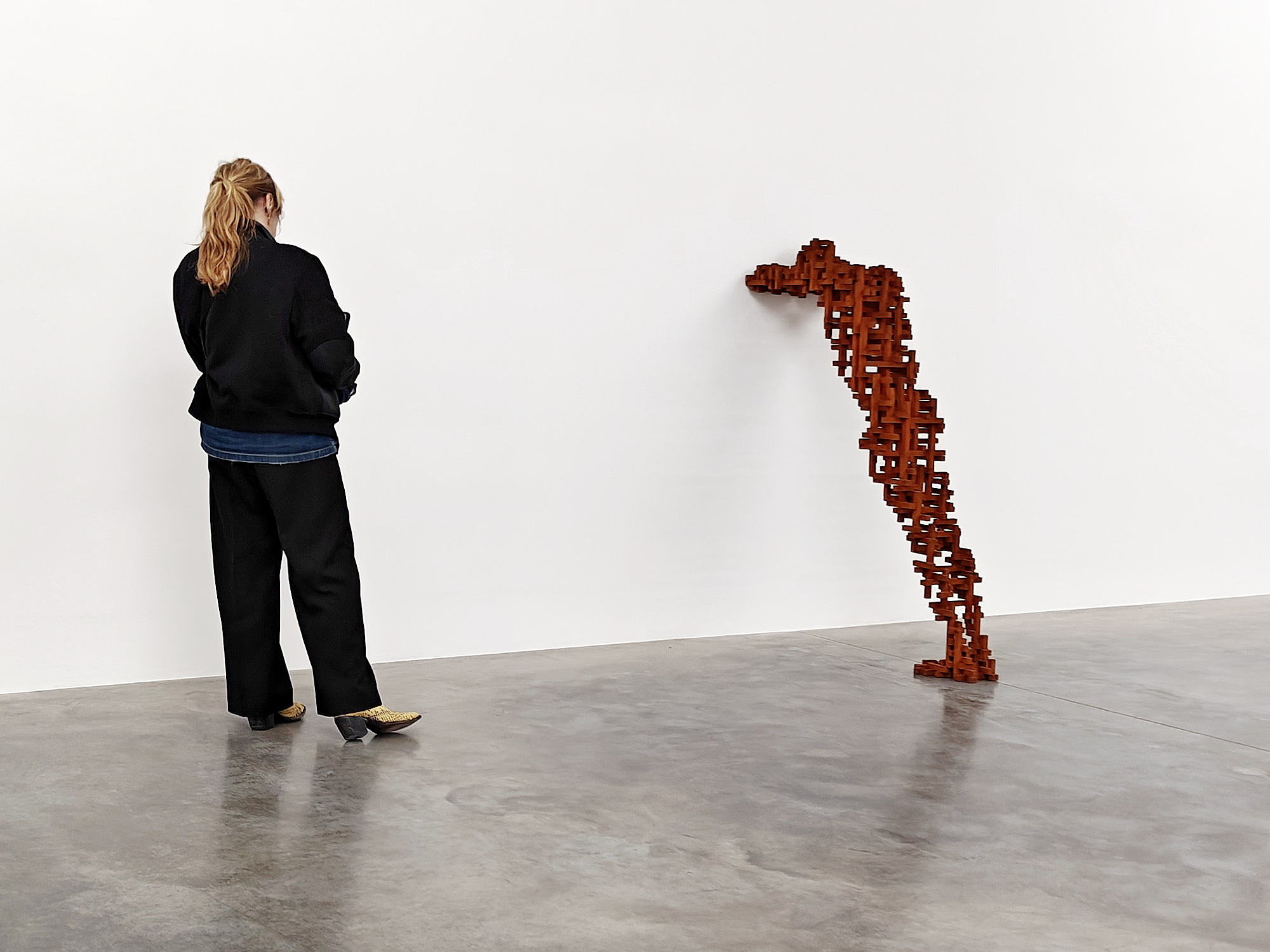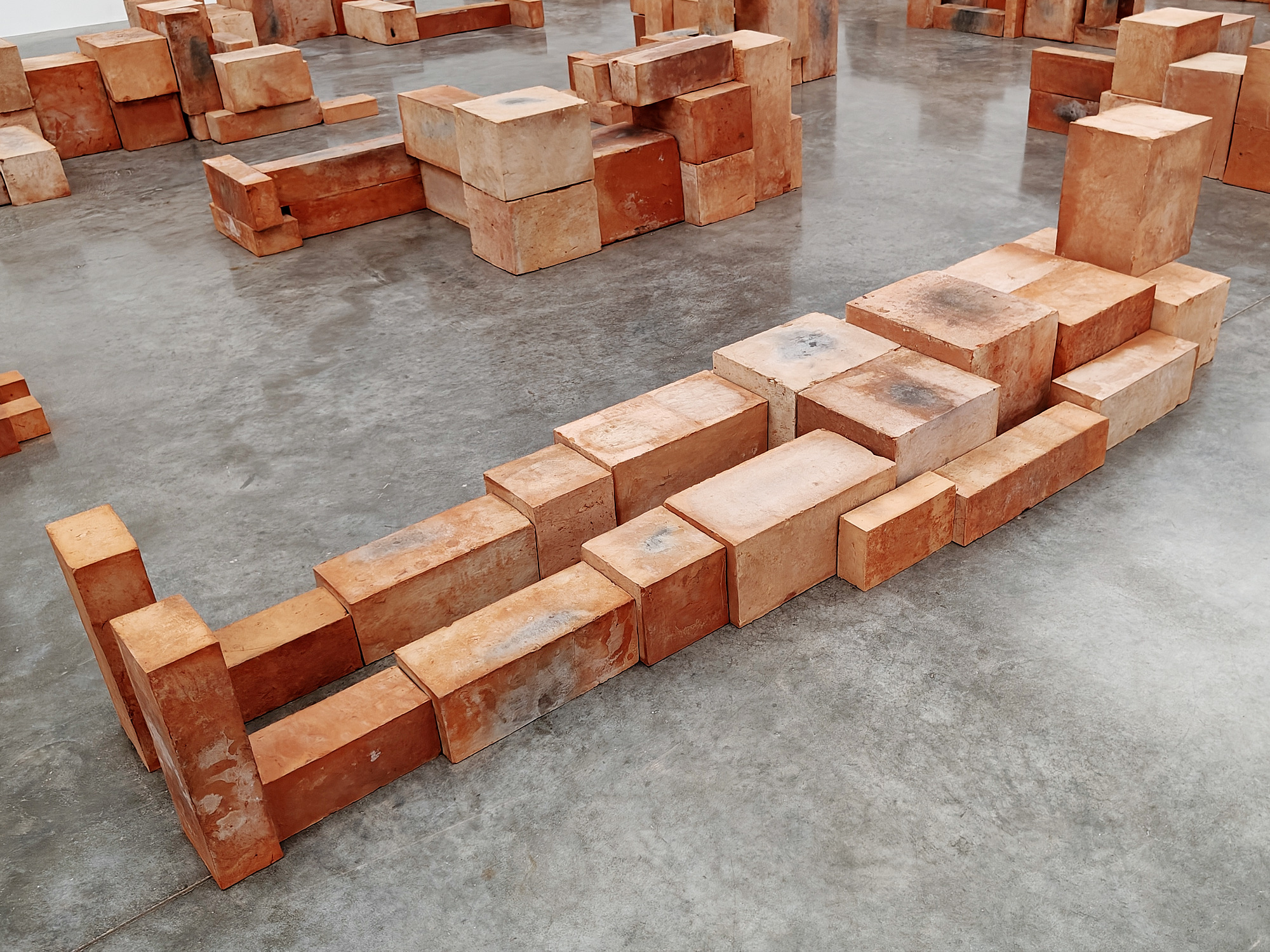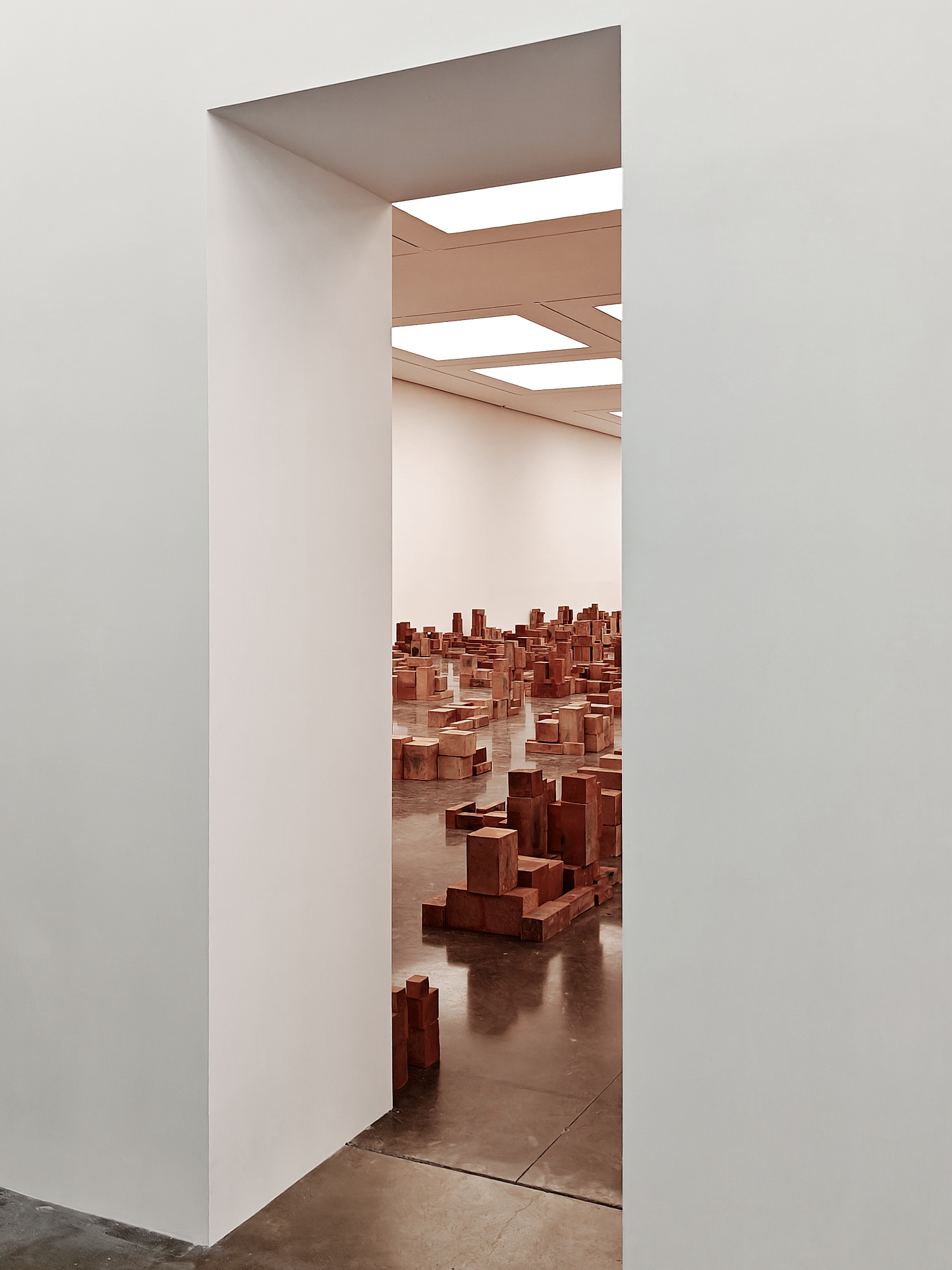Antony Gormley’s Body Politic, in the artist’s own words
An exhibition by celebrated sculptor Antony Gormley currently fills the expanses of White Cube Bermondsey in London. It is a true celebration of material & the processes of making, with works in Corten steel, concrete, & iron bars, with the largest gallery turned into a labyrinth of 244 clay sculptures.
Body Politic at White Cube Bermondsey is a deep study of material, processes, geometry, and void. Antony Gormley not only placed works into the spaces but reconfigured the very architecture itself to create a tight relationship between objects and context. Openings were relocated and narrowed, the floor was repolished to a specific quality, while one work, Bind (2023), seemed to configure itself floating in the centre of a gallery while rigidly connected to the walls and ceiling with extruded rolled black steel.
One of these extensions ran along the floor and through the repositioned doorway and perpendicular across the central corridor axis into an adjacent gallery. The corridor itself was punctured by a series of eight hollow concrete forms, Retreat (2022–23), based on the artist’s own body and which Gormley refers to as “intimate bunkers for one.”
At the opening of the exhibition, Gormley undertook a walk around the works freely responding to how they sit in the space. Here we reproduce a selection of the artist’s thoughts from this tour alongside images of the works he is responding to.
One of these extensions ran along the floor and through the repositioned doorway and perpendicular across the central corridor axis into an adjacent gallery. The corridor itself was punctured by a series of eight hollow concrete forms, Retreat (2022–23), based on the artist’s own body and which Gormley refers to as “intimate bunkers for one.”
At the opening of the exhibition, Gormley undertook a walk around the works freely responding to how they sit in the space. Here we reproduce a selection of the artist’s thoughts from this tour alongside images of the works he is responding to.






Test (2021-23)
“These works pay a huge debt to Bruce Nauman, for example, and those early 1960s experiments where artists worked out what to do in the 20th century, when the whole language of the statue had run its course.”
“These are simply instruments through which perhaps we become aware of our own experience of space and time and embodiment.”
“I want everything to be part of the work in a sense – the quality of the floor that has not been made too shiny, so there's a relationship between a hard, clean place, but also matt.”
“These works pay a huge debt to Bruce Nauman, for example, and those early 1960s experiments where artists worked out what to do in the 20th century, when the whole language of the statue had run its course.”
“These are simply instruments through which perhaps we become aware of our own experience of space and time and embodiment.”
“I want everything to be part of the work in a sense – the quality of the floor that has not been made too shiny, so there's a relationship between a hard, clean place, but also matt.”
Stand (2023)
“It's a game, it's a Jenga, but the fact is that it stays vertical while being very elegantly in a process of collapse.”
“This is the kind of Shelley Ozymandias. ‘Look on my works, ye Mighty, and despair!’ I wanted to acknowledge the despair. You could say that this is Napoleon standing with his arm akimbo, looking to the horizon for further opportunity of colonisation and exploitation – but at the same time, Napoleon is disintegrating.”
“There is a big cantilever there, the whole of the sculpture is carried by one of its elements down the bottom, and then again by a single element in the centre. I believe it's a remarkable demonstration of civil engineering techniques, but now used the make an imaginative object that questions its own identity.”
“It's a huge privilege to work with people that can make things like this, that you can't imagine how it's made. Maybe that's part of its mystique? I want to use the materiality, but also the magic of all of the tools that industrial production gives us today, but to make imaginative objects that make you wonder who we are, what we are made of, where we are going.”
“It's a game, it's a Jenga, but the fact is that it stays vertical while being very elegantly in a process of collapse.”
“This is the kind of Shelley Ozymandias. ‘Look on my works, ye Mighty, and despair!’ I wanted to acknowledge the despair. You could say that this is Napoleon standing with his arm akimbo, looking to the horizon for further opportunity of colonisation and exploitation – but at the same time, Napoleon is disintegrating.”
“There is a big cantilever there, the whole of the sculpture is carried by one of its elements down the bottom, and then again by a single element in the centre. I believe it's a remarkable demonstration of civil engineering techniques, but now used the make an imaginative object that questions its own identity.”
“It's a huge privilege to work with people that can make things like this, that you can't imagine how it's made. Maybe that's part of its mystique? I want to use the materiality, but also the magic of all of the tools that industrial production gives us today, but to make imaginative objects that make you wonder who we are, what we are made of, where we are going.”






Resting Place (2022-23)
“The least I say about it the better, but it's really lovely to watch the way people come in and see how the field of the sculpture makes people want to disperse and move through this labyrinth or maze.”
“The narrow threshold is really to make sure that you've come into the space alone, that the minute you come in, you're obliged in a way to find you're pathway through the work. I think that the threshold is a very simple way of reinforcing your singular presence, your particular adventure, your space-time journey.”
“For me, this is both an acknowledgement of displacement on the one hand – and you could say the migration crisis – but on the other hand, the acknowledgement that actually displacement is a fundamental species trait. Our species' success has been because we are able to exist in such a multiplicity of environments and have always been on the move. The history of our species is a history of migration.”
“The least I say about it the better, but it's really lovely to watch the way people come in and see how the field of the sculpture makes people want to disperse and move through this labyrinth or maze.”
“The narrow threshold is really to make sure that you've come into the space alone, that the minute you come in, you're obliged in a way to find you're pathway through the work. I think that the threshold is a very simple way of reinforcing your singular presence, your particular adventure, your space-time journey.”
“For me, this is both an acknowledgement of displacement on the one hand – and you could say the migration crisis – but on the other hand, the acknowledgement that actually displacement is a fundamental species trait. Our species' success has been because we are able to exist in such a multiplicity of environments and have always been on the move. The history of our species is a history of migration.”
“I want you to slow down, I want you to begin that job of interpretation. Because these need to be looked at, you need to do the job of assembling the parts into a whole and finding the ones that you maybe have the most connection with. And some of them are very difficult to read at first – maybe you have to walk around it, whereas others can be seen completely.
“The idea of interpretation is really important – you've got 70 tonnes of clay, all meaningless really, until the viewer gives this material that conscious attention.”
“The clay is a consistent body, but depending on where it is in the kiln and the levels of reduction, which is caused by a lack of oxygen, basically the red which is the iron in the clay is starved of oxygen and goes black as it carbonises. So, I've tried to use I've tried to use that variation in colour in a way that animates the field as a whole.”






“I think that art is an instrument by which that capability that we all have, can be felt. It seems to me that we're in a very powerless, critical time, we are all aware of the absolute urgency of the climate crisis, we are all aware of massive divisions between rich and poor – inequality has never been greater – we are all aware that we are still using unbelievably barbaric means to solve our difference, and this doesn't bode well for our human future, or indeed the future of the planet. So there’s a need for a register – that's what I think this is – which provides a reflexive ground where, perhaps, the value of individual experience is put above the value of a particular object.”
“I don't want this to be agitprop thing. It's simply a reflexive environment in which perhaps we can become aware of feelings of sympathy, or fear.”
Antony Gormley is widely acclaimed for his sculptures,
installations and public artworks that investigate the relationship of the
human body to space. Gormley’s work is concerned with the experience of being
in the world and an expression of how it feels to be alive. Through a critical
engagement with his own physical existence, Gormley identifies art as a place
where new behaviours, thoughts and feelings can arise. For him, art can be a
place of becoming where, collectively, we can think about our role as creators
of the future: “I want it to be about life. I want it to be about potential.”
Gormley was awarded the Turner Prize in 1994, the South Bank
Prize for Visual Art in 1999, the Bernhard Heiliger Award for Sculpture in
2007, the Obayashi Prize in 2012 and the Praemium Imperiale in 2013. In 1997 he
was made an Officer of the British Empire (OBE) and was made a knight in the
New Year’s Honours list in 2014. He is an Honorary Fellow of the Royal
Institute of British Architects, an Honorary Doctor of the University of
Cambridge and a Fellow of Trinity and Jesus Colleges, Cambridge. Gormley has
been a Royal Academician since 2003.
www.antonygormley.com
Gormley was awarded the Turner Prize in 1994, the South Bank Prize for Visual Art in 1999, the Bernhard Heiliger Award for Sculpture in 2007, the Obayashi Prize in 2012 and the Praemium Imperiale in 2013. In 1997 he was made an Officer of the British Empire (OBE) and was made a knight in the New Year’s Honours list in 2014. He is an Honorary Fellow of the Royal Institute of British Architects, an Honorary Doctor of the University of Cambridge and a Fellow of Trinity and Jesus Colleges, Cambridge. Gormley has been a Royal Academician since 2003.
www.antonygormley.com


